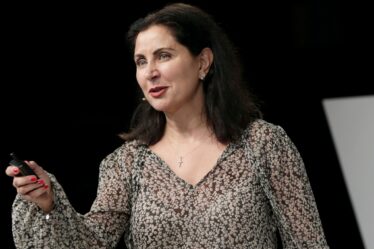
A recent Gallup survey found that globally, 79 percent of employees are either not engaged or are actively disengaged at work. With employees working at home, in the office and on the road, companies need to utilise attention-grabbing digital solutions to engage employees.
Brandlive launched in 2010 as a company designed to host in-person events and product launches. The pandemic saw the company switch gears as in-person events ground to a halt and Brandlive became a digital platform that has since hosted thousands of webinars and events of all kinds for its partners, including GoPro, Intuit, Sony and Square.
Most recently, Brandlive has focused on the inner workplace opportunities, to “bring the magic of television to work”. Today, it offers streaming solutions for B2B and internal communications, designed to make all-hands meetings, webinars and onboarding processes more dynamic and engaging.
The average American consumes over 5 hours a day of video, which is only set to increase, as shared by Michael J. Wolf, co-founder and chief executive of management consulting firm Activate, Inc., at the BoF Professional Summit. Millennial and Gen-Z — two groups who typically prefer video content to text — now make up over half of the workforce globally. Brandlive has found reflecting that preference for video content consumption can increase engagement for those in the office and at home.
Brandlive offers tools like “Hubs” to organise video content for employees to access at any time to support a workforce that operates asynchronously. For company leaders, this offers a way to connect with their team any time of the global day.
This solution is designed to speak to the future of work, tailored to employee preferences both for video comms and to a desire for hybrid work. Indeed, a Harvard Business School study in 2021 found that 81 percent of professionals either did not want to return to the office or would prefer a hybrid schedule.
Now, BoF sits down with Brandlive’s chief people officer Chris Miller to learn more about its solution for companies looking to re-engage employees working from home in the TikTok era, through offering more dynamic virtual live events and video content.
What led Brandlive to create an internal event platform for companies?
Brandlive was a tech platform originally built to execute in-person events and product launches. However, our CEO Sam [Kolbert-Hyle] realised that businesses like Nike were using our platform inside their organisations for internal meetings like all-hands.
The general consensus was that all-hands meetings are boring and lack engagement, and it can be hard to engage a full audience in virtual, cross-company meetings.
So, the idea was to elevate these meetings from a simplistic, one-dimensional experience, to video that engages the audience and can ultimately look and feel like television content.
How can content created on Brandlive improve employee engagement?
Brandlive is a software as a service, but it’s also the delivery and execution of content. We believe it is advantageous to have this notion of “Netflix for work” — your meeting content can look and feel like many of your streaming platforms, and your employees can digest the content when it suits them.
The idea was to elevate these meetings from a simplistic, one-dimensional experience.
A key layer is offering content on-demand. With a workforce in different geographies, or for an organisation of, say, 1,200 people, it is more and more unrealistic to host a monthly all-hands that everyone can attend. If you make the content engaging to watch, people will come back and watch it post-meeting.
What role does video content have in the future of work?
The pandemic saw a massive increase in video consumption. In particular, short-form video is becoming the main way people want to digest information on a regular basis, especially for Gen-Z and Millennials. After all, TikTok alone has over a billion monthly users.
If you look at that from a people and culture standpoint, we need to rethink how we disseminate information to make sure we attract, retain and develop our people. During onboarding, for example, you might share a 68-page employee handbook. I doubt everyone reads all 68 pages, so I would instead take that handbook and make a series of 10 to 15 short videos on key information like “our policy on travel” or “how to submit your expenses”.
So, rather than wading through a massive document, employees can instead watch a three-minute video on everything you need to know on one topic. You can then use Brandlive as a home base for linking out to other systems to improve the user experience.
What tools can Brandlive partners access to make engaging content?
We’re trying to lower the barriers to entry for our clients, so anyone can create high quality video content. We recognise that not every client can have a creative team on site, or a high quality camera, studio or green room. So, the next level of evolution for Brandlive is ensuring you don’t have to have all of those functions to produce engaging content.
We have a Greenroom product through which you can build templates, create lower thirds and insert transitions with easy-to-use tools, so you won’t need someone on our side to walk you through all these things. If you do need assistance, we have a Brandlive Studios team here, comprised of graphic animators to creative directors, who can help make this or that element more engaging.
Our iOS app is also offering a lower barrier to entry as it offers the tools for creation on your mobile, on which you most likely already have a great camera. The app also means that an executive or team lead can be on the road, visiting a client, but still engage in a meeting hosted on Brandlive in an engaging format.
How do you envision this product will evolve in the future?
The next step will be artificial intelligence (AI), and how it will start to change how we digest and create content. We are still in the infancy stage of understanding what role AI has to play in the future for us, but we are interested in predictive analytics around attendance and engagement metrics.
AI could help us predict where you may have retention issues.
For example, a webinar is primarily designed to push products or messaging to a targeted audience, so AI could play a part in identifying that target audience. Alternatively, people teams often run engagement surveys and aggregate the data. AI could help us predict where you may have retention issues from data trend analysis, to understand when a team is showing signs that they are losing engagement. Getting ahead of that is going to be huge.
What data analytics does Brandlive provide its partners?
Within our software platform, there are three pillars for data and analytics. The most straightforward is registration. Whether your event is external or internal, with partners or employees, we can dice those analytics in terms of where those registrants are coming from and help you understand how successful your marketing was.
The second pillar is around attendance rate and watch time which are useful benchmarks for understanding your conversation rate and determining how successful your content was. If you are running a longer show with multiple segments, audience participation may go up or down and the analytics on viewing numbers offers insights on what people were most and least interested in watching.
The third pillar for us is engagement, meaning: how many questions were asked; how active was the chat; were quiz questions answered correctly; did users click on links or view documents. This is data is highly valuable when it comes to understanding employee participation and for external events, qualifying leads.
This is a sponsored feature paid for by Brandlive as part of a BoF partnership.



